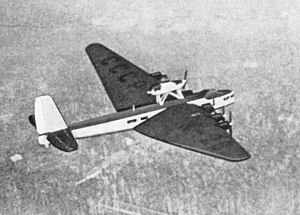Tupolev ANT-20 Maxim Gorky
| ANT-20 | |
|---|---|
 |
|
| ANT-20 "Maxim Gorky" | |
| Role | Propaganda aircraft/Transport |
| National origin | Soviet Union |
| Manufacturer | Tupolev |
| First flight | 19 May 1934 |
| Introduction | 1934 |
| Retired | 1942 |
| Primary user | Soviet Union |
| Number built | 2 |
| Developed from | Tupolev TB-4 |
The Tupolev ANT-20 Maksim Gorki (Russian: Туполев АНТ-20 "Максим Горький") was a Soviet eight-engine aircraft, the largest of the 1930s. Its wingspan was similar to that of a modern Boeing 747, and was not exceeded until the 64.6 meter wingspan, American Douglas XB-19 heavy bomber prototype first flew in the early summer of 1941.
The ANT-20 was designed by Andrei Tupolev, using all-metal airframe technology devised by German engineer Hugo Junkers during the World War I years, as the largest-ever aircraft to use Junkers' original all-metal aircraft design techniques from 1918, being constructed between 4 July 1933 and 3 April 1934. It was one of two aircraft of its kind built by the Soviets. The aircraft was named after Maxim Gorky and dedicated to the 40th anniversary of his literary and public activities. The ANT-20 was the largest known aircraft to have used the Junkers design philosophy of corrugated sheet metal for many of the airframe's key components, especially the corrugated sheet metal skinning of the airframe.
It was intended for Stalinist propaganda purposes and was equipped with a powerful radio set called "Voice from the sky" ("Голос с неба", Golos s neba), printing machinery, a library, radiostations, a photographic laboratory and a film projector with sound for showing films in flight. In a first-in-aviation history the aircraft was equipped with a ladder which would fold on itself to become part of the floor.
Another first for the plane is that it used both direct current and alternating current. The aircraft could be dismantled and transported by rail if needed. The aircraft set several carrying-capacity world records and is also the subject of a 1934 painting by Vasily Kuptsov, which is now in the collection of the Russian Museum at St. Petersburg.
...
Wikipedia
